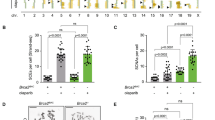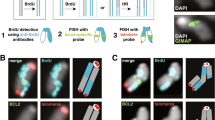Abstract
SISTER chromatid exchange (SCE), that is, the reciprocal interchange of DNA between chromatids, is easily visualised in metaphase chromosomes1,2 and has been applied to study chromosome structure3,4, chromosome damage5, and instability and DNA repair deficiency syndromes6–9. Since SCEs can be induced by subtoxic doses of carcinogens and mutagens5,10–13, their analysis offers the possibility of a rapid, sensitive and quantitative assay for genetic damage. We have begun to examine the relation between SCEs and mutations in Chinese hamster ovary (CHO) cells by quantifying the induction of SCEs in parallel with the induction of mutations producing 8-azaguanine resistance, that is, mutations predominately at the hypoxanthine phosphoribosyltransferase, hprt, locus. Since the conversion of a chemically induced DNA lesion to a SCE or mutation may depend on the nature of that lesion, we tested four chemicals that differ in their interaction with DNA—ethyl methanesulphonate (EMS; O6: N7 guanyl alkylation ratio14 of 0.03), N-ethyl-N-nitrosourea (ENU; O6: N7 guanyl alkylation ratio15 of about 0.35), the crosslinking agent mitomycin C (MMC)16 and the intercalator proflavine sulphate (PRO)17. Our results indicate a linear relation between induced SCEs and mutations. The relative efficiency, however, is different for each chemical.
This is a preview of subscription content, access via your institution
Access options
Subscribe to this journal
Receive 51 print issues and online access
$199.00 per year
only $3.90 per issue
Buy this article
- Purchase on Springer Link
- Instant access to full article PDF
Prices may be subject to local taxes which are calculated during checkout
Similar content being viewed by others
References
Latt, S. A. Proc. natn. Acad. Sci. U.S.A. 70, 3395–3399 (1973).
Perry, P. & Wolff, S. Nature 251, 156–158 (1974).
Wolff, S. & Perry, P. Chromosoma 48, 341–353 (1974).
Tice, R., Chaillet, J. & Schneider, E. L. Nature 251, 70–72 (1975).
Perry, P. & Evans, H. J. Nature 258, 121–125 (1975).
Chaganti, R. S. K., Schonberg, S. & German, J. Proc. natn. Acad. Sci. U.S.A. 71, 4508–4512 (1974).
Wolff, S., Rodin, B. & Cleaver, J. E. Nature 265, 347–349 (1977).
Latt, S. A., Stetten, G., Juergens, L. A., Buchanan, G. R. & Gerald, P. S. Proc. natn. Acad. Sci. U.S.A. 72, 4066–4070 (1975).
Galloway, S. M. & Evans, H. J. Cytogenet. Cell Genet. 15, 17–29 (1975).
Solomon, E. & Bobrow, M. Mutat. Res. 30, 273–278 (1975).
Popescu, N. C., Turnbull, D. & DiPaolo, J. A. J. natn. Cancer Inst. 59, 289–293 (1977).
Latt, S. A. Proc. natn. Acad. Sci. U.S.A. 71, 3162–3166 (1974).
Takehisa, S. & Wolff, S. Mutat. Res. 45, 263–270 (1977).
Lawley, P. D. Mutat. Res. 23, 283–295 (1974).
Singer, B. Nature 264, 333–339 (1976).
Iyer, V. N. & Szybalski, W. Science 145, 55–58 (1964).
Luzzati, V., Masson, F. & Lerman, L. J. molec. Biol. 3, 634–639 (1961).
Thompson, L. H. & Baker, R. M. Meth. Cell Biol. 6, 208–281 (1973).
Ohta, T. & Kimura, M. Nature 233, 118–119 (1971).
Author information
Authors and Affiliations
Rights and permissions
About this article
Cite this article
CARRANO, A., THOMPSON, L., LINDL, P. et al. Sister chromatid exchange as an indicator of mutagenesis. Nature 271, 551–553 (1978). https://doi.org/10.1038/271551a0
Received:
Accepted:
Published:
Issue Date:
DOI: https://doi.org/10.1038/271551a0
This article is cited by
-
Multi-platform profiling characterizes molecular subgroups and resistance networks in chronic lymphocytic leukemia
Nature Communications (2021)
-
In vitro genotoxicity and cytotoxicity of a particular combination of pemetrexed and cefixime in human peripheral blood lymphocytes
SpringerPlus (2015)
-
Is stem cell chromosomes stability affected by cryopreservation conditions?
Cytotechnology (2008)
-
In Vivo Induction of Sister Chromatid Exchanges (SCE) in a Tropical Fish, Etroplus suratensis (Bloch)
Acta Biologica Hungarica (1997)
-
The diplochromosome of endoreduplicated cells: A new approach to highlight the mechanism of sister chromatid exchange
Chromosoma (1996)
Comments
By submitting a comment you agree to abide by our Terms and Community Guidelines. If you find something abusive or that does not comply with our terms or guidelines please flag it as inappropriate.



